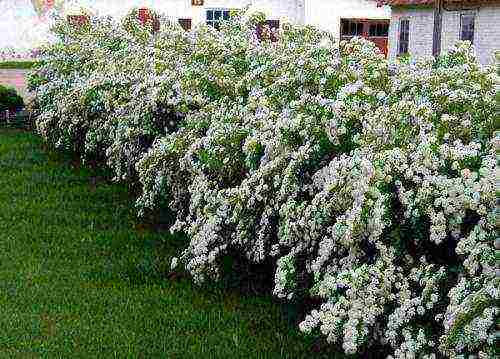Content
- 1 Spirea: types and varieties
- 2 Spirea: features of cultivation
- 3 Shrub propagation
- 4 Landing in open ground
- 5 Outdoor care for spirea
- 6 Plant diseases and pests
- 7 The nuances of growing in Siberia, in the Urals, in the Moscow region
- 8 Planting and growing vegetables and fruits, caring for the garden, building and repairing a summer house - all with your own hands.
- 9 Reproduction of the bladder
- 10 How and when does the spirea plant
- 11 Spirea care
- 12 Reproduction of the spirea bush
- 13 Varieties of spirea and their varieties
- 14 Shrub in landscape design
Among the ornamental shrubs, spirea occupies a special place. She is surprisingly unpretentious and easily forgives the gardener even the most unobtrusive care. A wide variety of shapes and types allows you to choose the plant to decorate the site that will best fit into the surrounding landscape. Planting and caring for a spirea is not difficult, even a novice gardener can handle it.
Spirea: types and varieties
The genus spirea belongs to the pink family and is quite numerous, it includes more than 70 species. The distribution area of this deciduous shrub is wide. It can be found in the northern hemisphere in most climatic zones. Spirea rarely has single flowers, most often they are collected in a corymbose inflorescence, sometimes in a panicle. The color of flowers depends on the flowering time of the species. Plants blooming in spring have white flowers that bloom on last year's shoots, in species blooming in summer, pink-crimson gamut prevails, flowers are located on annual growths.
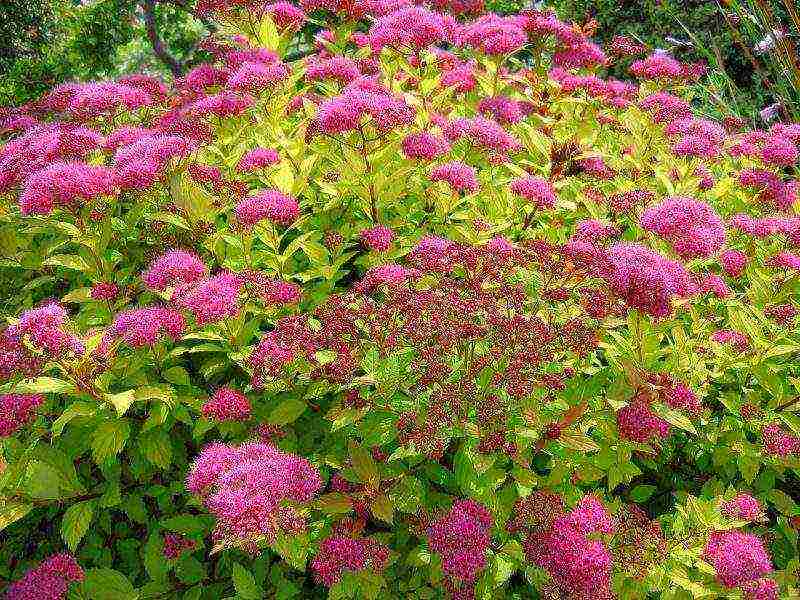
The most common types.
- Medium spirea - an inhabitant of Siberian and Far Eastern forests, a tall shrub - above 2 m with white corymbose flowers that open in May and do not fall for 3 weeks, frost-resistant and drought-resistant, used in landscaping, suitable for northern regions.
- Spiraea birch-leaved - grows in Siberia, from 1 to 2 m in height, white flowers are collected in huge shields - up to 10 cm in diameter, blooms at the end of May and blooms throughout June.
- Spirea crenate - has been used in landscaping for 200 years, there are cultural hybrid varieties. In nature, it is a low shrub, only up to 1 m, blooming at the end of May. Quite large flowers are collected in corymbose inflorescences, due to the large number of long yellow stamens, it seems that they have a golden hue. This type of spirea is drought-resistant and frost-hardy, can be used to strengthen floating soils.
- Spirea St. John's wort is a shrub up to 1 m high, flowering - May-June, white flowers, used to obtain new forms of the plant.
- Gray spirea - the result of crossing the previous species and whitish-gray spirea, has highly decorative varieties that bloom in spring. The most beloved variety of this species by flower growers is Spirea Grefsheim. The shoots of the tall bush bend towards the ground under the weight of flowers that completely cover the bush. The flowering is so abundant that the leaves are practically invisible.
- Spiraea is oak-leaved - blooms with umbrella-shaped inflorescences of white flowers with a large number of protruding stamens for 25 days, flowering occurs in May-June. The species is used in culture, it tolerates a haircut well.
- Spirea Nipponskaya came to us from Japan - this highly ornamental shrub 1-2 m high is decorated with yellowish-white shields of inflorescences that appear in June. It does not differ in frost resistance; in severe winters, the tops of the shoots freeze slightly, but quickly recover. The most famous variety is Snowmound. A huge number of flowers on a bush up to 1.5 m high makes it very decorative at the time of flowering. The width of the bush is 2 times the height.
- No less decorative and spirea Wangutta is a hybrid species that blooms very profusely in June-July with white flowers collected in shields. The bush has an average height and can freeze slightly in frosty winters.
- Japanese spirea is quite thermophilic, but due to the low height of the bush - up to 1 m it winters without losses, covered with snow. The most interesting varieties are Little Princesses and Shirobana. Little princesses - a bush up to 80 cm high and up to 1.2 m wide blooms very profusely in June-July with pink flowers collected in medium-sized shields, grows slowly. Shirobana is a bush up to 0.8 m high and up to 0.6 m wide, blooms in mid-summer. Flowers in corymbose inflorescences have three colors - white, pink and crimson, if you cut off faded inflorescences, new ones will decorate the bush for another month.
- The adorable spirea stands out among other species by double flowering: in June on last year's shoots and in July and August on newly regrown ones. Flowers are collected in complex shields, can be white or pale pink. The species does not differ in frost resistance - up to -18 degrees, so in the middle lane it hibernates under cover.
- Spirea Bumald is a decorative hybrid species, it also has a yellow-leaved form. The bush is low - up to 0.8 m in width and height. It blooms for more than 3 months with bright pink flowers in large shields. The most famous variety is Antoni Vaterer.
- Willow spirea grows wild in Siberia. The tall bush blooms in July and August with bright pink flowers collected in pyramidal panicles.
- Spirea Douglas grows above 2 m.In the second half of summer, it is decorated with pink flowers, collected in a paniculate inflorescence.
- When crossing the previous species and spirea willow leaf we got Billard's spirea. A tall, frost-resistant shrub blooms in the second half of summer and is decorated with large pink paniculate inflorescences until the very frosts.
- Also, the hybrid spirea is lilac-colored for a long time, only paniculate inflorescences, in accordance with the name, have a lilac-pink color. The bush can grow up to 2 m.
Spirea: features of cultivation
Spireas are unpretentious, but with proper careful care they give abundant flowering. Different flowering times dictate different pruning times. Some species and varieties have special soil and maintenance preferences. Most spirits prefer humus-rich, but not heavy soil without stagnant water, but they will feel good even on not very fertile soil. To keep the roots from getting wet, they need drainage. But before you plant a plant, you need to propagate it.
Shrub propagation

Spirea is very easy to propagate. Some species produce root shoots that can be transplanted. Parts of a divided bush take root well. Flexible shoots allow cuttings to be rooted. For propagation of all species, cuttings can be used, and for non-hybrid forms and varieties, seeds can also be sown.
Cuttings
When rooting the cuttings, you will get an exact copy of the parent plant. Green cuttings in early flowering varieties are cut in early June, and in late flowering varieties at the end of the month. For already lignified cuttings, the best rooting time is autumn, September or October.
- The annual green shoot is cut and cut into pieces with 5-6 leaves.
- Remove the bottom pair of leaves, cut the rest by half.
- The lower cut is placed in a vessel with an epin solution for 12 hours.
- It is treated with a powdery root stimulant.
- They are planted in a container with loose soil, sprinkled with a layer of sand at an angle of about 40 degrees to stimulate root formation.
- Cover with foil or glass jar and put in lacy shade under the trees.
- They moisten the soil in the cuttings, preventing it from drying out, and the cuttings themselves are sprayed several times a day.
- In autumn, the container is dropped into the soil, mulched with fallen leaves and covered with a wooden box.
- In the spring, the shelter is removed. After the appearance of young shoots, the plants are planted in the garden in a permanent place.
Seed propagation
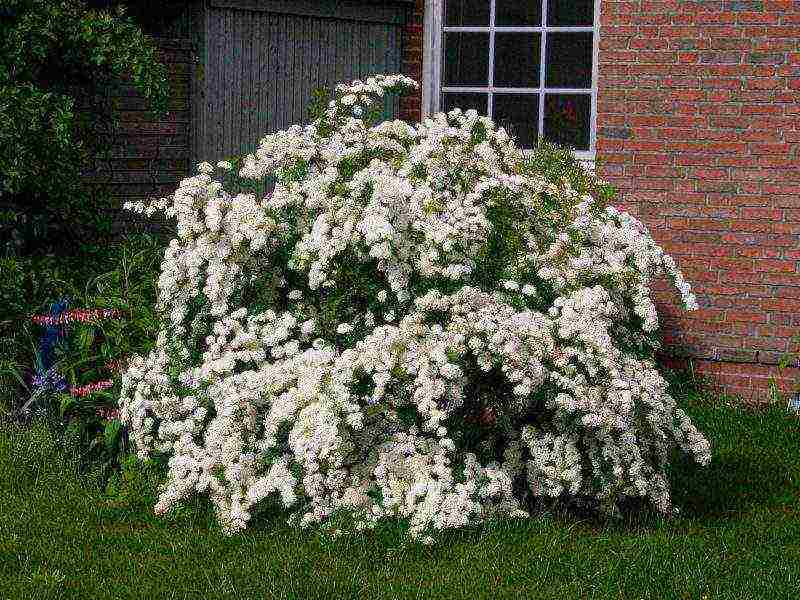
In non-hybrid varieties and species, seed germination reaches 80%. Collect them when the boxes turn brown, but have not yet opened. Dose in the room for 2 weeks. You can sow both before winter and in spring. Seeds do not require stratification. Seedlings dive when 2 true leaves are formed. Further care: watering as needed, 2 dressings with full mineral fertilizer. In the fall, seedlings are planted in a seedling bed, and next year in a permanent place. They begin to bloom for 3 years.
Landing in open ground
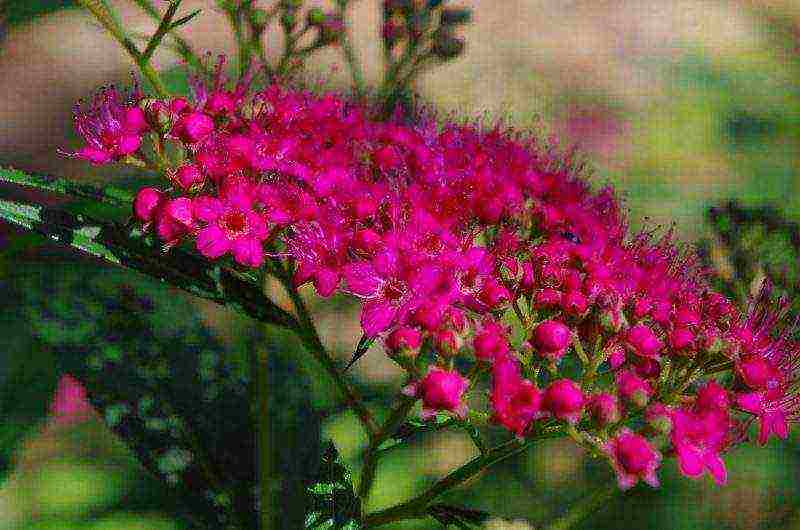
Proper planting is the key to abundant flowering and plant health. It is very important to maintain the optimal distance between the plants in order to provide them with the necessary nutritional area. When laying a hedge, it is enough to plant spireas 30 cm apart, for a normal planting the distance should be greater, since the bushes grow strongly in width: for tall varieties - about 1 m, for undersized varieties - 0.8 m.
The choice of planting material
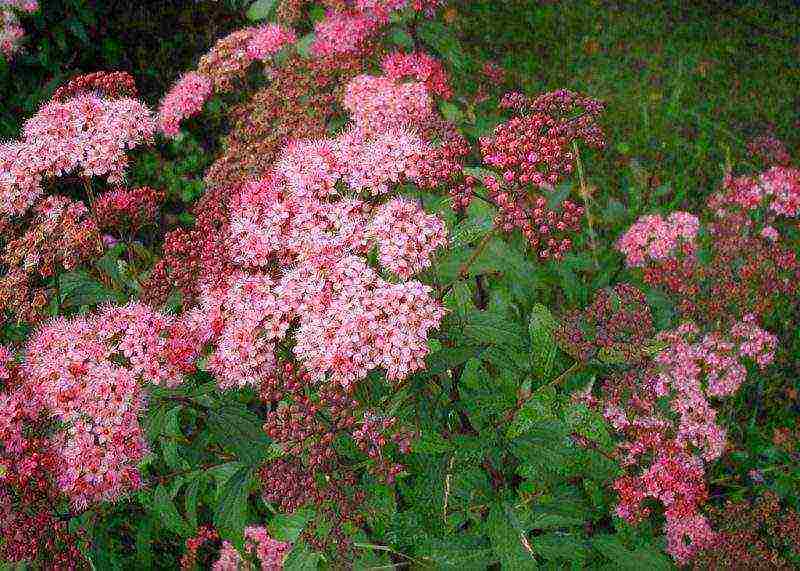
Now on sale there are many varieties and hybrids of spirea. The choice of a plant depends, first of all, on what place the spirea will occupy in the landscape design of a particular site. A hedge will require many plants of the same species, it is better if they are tall. As a tapeworm, you can plant an openwork bush with long flowering. On an alpine slide, undersized compact varieties will be appropriate. But whichever variety you choose, the plant must have a developed and healthy root system, consisting of 3 taproots and a well-developed lobe covered with a clay mash. With spring planting, not swollen buds, and with autumn planting, already flown leaves. It is best to choose a container-grown seedling that can be planted throughout the growing season.
How and when to plant?
Spirea is planted in pre-dug holes. Their size should be slightly larger than the root system of the plant. Usually the depth is about 70 cm, 20 of which falls on the drainage of expanded clay or brick fragments. The diameter of the hole is determined by the size of the roots.
Landing Algorithm:
- a plant is placed on a mound of earth poured in a hole, spreading the roots;
- fill up the earth, taking into account that the root collar is strictly at the level of the soil;
- watered in the planting circle using 2 to 3 buckets of water;
- mulch the soil around the bush with a layer of peat 7 cm thick.
Planting time depends on the selected variety: late flowering plants are planted in spring, early flowering ones - in autumn, but no later than 3-4 weeks before the onset of frost.
Soil preparation and site
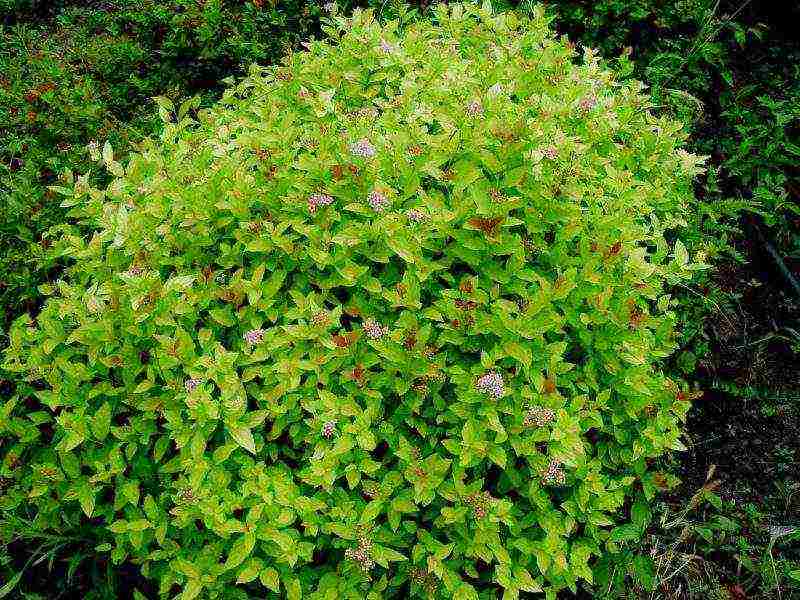
The planting site should be well lit by the sun, a little shading is allowed during the day. It must be remembered that in the shade of the spirea it blooms badly.
This plant is undemanding to the soil. The preferred soil for spirea is light sod or leafy, with a neutral or slightly acidic soil reaction. Heavy clay soils are improved by the addition of sand and peat, a little clay should be added to light sandy soils. From fertilizers, you can add Art. tablespoons of long-acting ABA fertilizer for each bush. This amount will be enough for the plant for several years.
The nuances of planting in spring, autumn
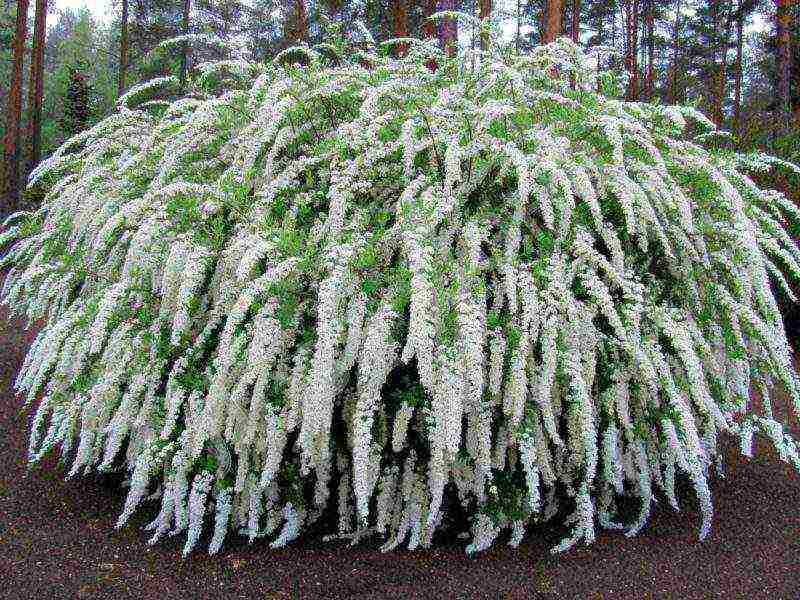
If the variety blooms in summer, it is better to plant it in spring, early flowering varieties are planted in autumn, but so that the bushes take root before the onset of frost. In both cases, the plants must be dormant. In the spring, the buds should not swell yet, and in the fall the leaf fall should already end.
Outdoor care for spirea
An unpretentious plant does not require special care measures, but top dressing and watering made on time will provide it with maximum decorative effect.
How to water properly?
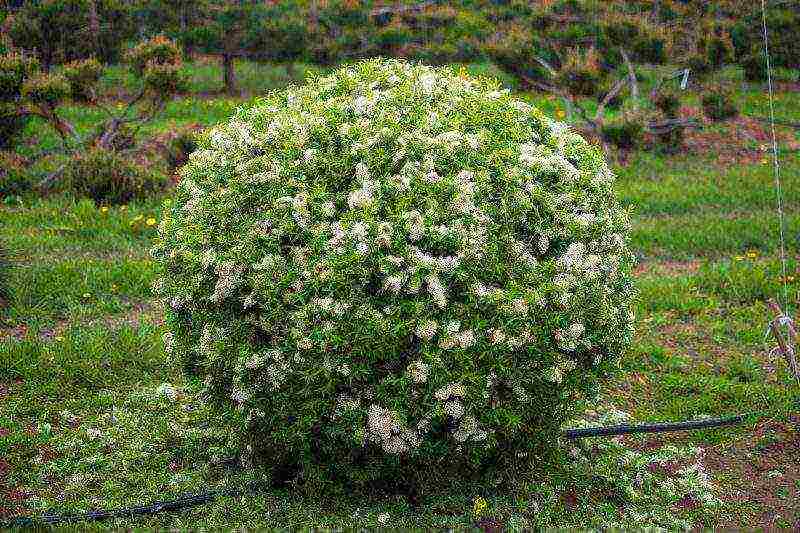
Spirea is a drought-resistant plant, but in extreme heat and in the absence of rain for a long time, it must be watered. This is especially true for recently planted bushes. For an adult plant, the watering rate is 1.5 buckets per bush. For undersized species and varieties, one bucket is enough. Watering is sufficient once every 2 weeks, well soaking the root layer.
Fertilization and feeding
In order for the spireas to grow and bloom well, they should be fed regularly.
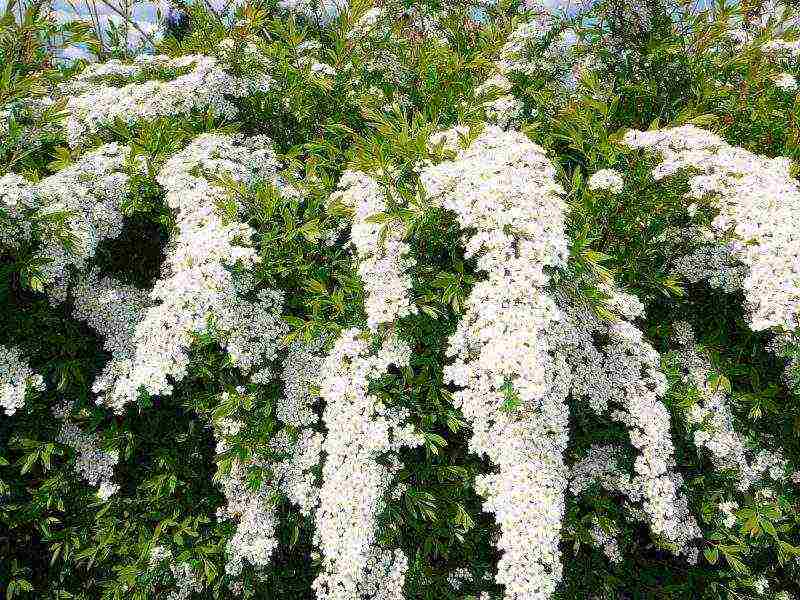
You can choose the following power plan:
- in spring, nitrogen mineral or organic fertilizer; for early flowering varieties, additional feeding with complete mineral fertilizer with microelements is needed;
- in June, plants are fed with full mineral fertilizer;
- at the end of August, fertilizing with phosphorus and potassium salts is needed so that the spireas are better prepared for winter.
At the end of summer, spireas cannot be fed with any fertilizers containing nitrogen, this can provoke the growth of new shoots that do not have time to ripen and freeze in winter.
All dressings can be applied both dry and liquid, combining them with watering. The next day, the soil around the plant must be loosened.
Spirea pruning
It is held on several dates, depending on the destination.
- Spring pruning is sanitary. Only dry and frost-damaged shoots are removed.
- Formative. Spireas blooming in the summer on the shoots of the current year are pruned in the spring immediately after the snow melts, combining formative pruning with sanitary pruning. Thin branches thickening the bush are removed - they will not give a good flowering. Different types of spirea have their own subtleties in pruning. Pruning of Douglas and Boomald spirits begins only in the fourth year of life. Miniature varieties not exceeding 40 cm in height are cut into 2 buds. Cut out shoots with foliage that does not match the color of the variety. After flowering, the seed pods are removed, if there is no need for seeds - this contributes to the re-blooming of the inflorescences. It is enough to cut off a third of the shoot. The green hedge is trimmed to give the desired shape. Spring-flowering spireas form after flowering, cutting off shoots at the level of a strong young growth. The crown of the bush should be symmetrical.
- Anti-aging pruning. It is carried out in adult bushes, starting from the 7th year of life. All old shoots are removed, leaving no more than 5-7 young ones, while maintaining the symmetry of the bush. This pruning is best done in several stages, so as not to greatly weaken the bush.
Preparing for winter
The first wintering at a recently planted bush is a serious test. But adult plants, despite the frost resistance of most varieties, and species also need to be prepared for winter. For many of them, it is enough to feed the plants in August with potash and phosphorus fertilizers, to carry out moisture-charging irrigation after leaf fall and to mulch the trunk circle with humus.
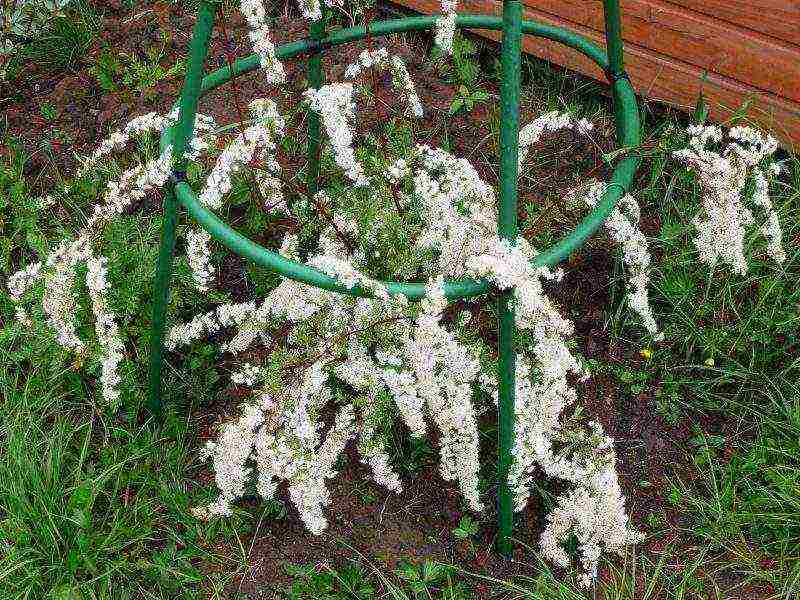
For less frost-resistant varieties, you will have to build a shelter:
- tie the branches into a bunch;
- bend the beam to the ground, fixing with special fasteners;
- fall asleep with dry leaves;
- additionally throw in snow.
Plant diseases and pests
Spiraea rarely suffers from disease, but in a damp summer it can be damaged by powdery mildew and gray mold. To eliminate them, copper-containing fungicides, Fitosporin, colloidal sulfur are used.
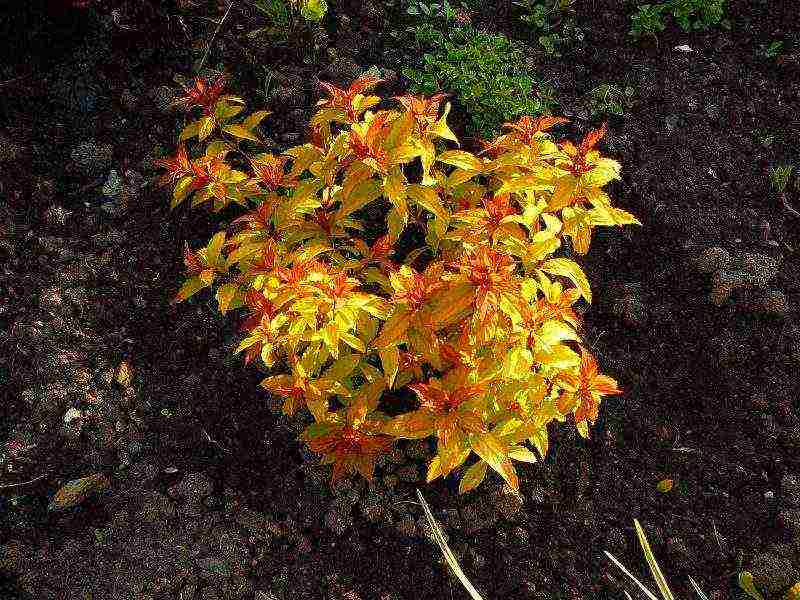
Among the most common pests are aphids, blue meadow sawfly, whitefly and spider mites. Insecticides are effective against the first three: Fitoverm, Actellik. Insectoacaricides are suitable against the tick: Metaphos.
The nuances of growing in Siberia, in the Urals, in the Moscow region
Almost all varieties and types of spirea are suitable for growing in central Russia. Shrubs such as Japanese Spirea and Nippon Spirea need additional winter shelter.

In the Urals, the climate is more severe.In its southern part, almost all types of spirits will grow well. In the middle lane and, especially in the north, frost-resistant shrubs should be preferred. The same can be said for spirea in Siberia. Only undersized varieties are able to overwinter under the snow without much loss. If medium and tall plants are not covered, then constant frosting in winter is guaranteed to them, decorativeness and abundant flowering cannot be achieved in such conditions.
Correctly selected varieties of spirea are able to create a flowering conveyor throughout the growing season and will be a real decoration of any garden.
Planting and growing vegetables and fruits, caring for the garden, building and repairing a summer house - all with your own hands.
Whatever they called him!
AND spirea calyx, and American bladderwormand finally bladderworm - eventually Physocarpus opulifolius…
(Physocarpus opulifolius) includes 14 species originating from North America (that's why American) and East Asia.
The first mentions of its appearance in our area appeared at the end of the 18th century. (1793), and along with the generic name of spiraea (Spiraea opulifolia), then one more, now forgotten, was used - nellia (Neillia opulifolia)... At the end of the XIX century. decorative forms of the vesicle have already appeared - yellow-leaved (luteus), golden-bordered (aureo-marginatum) and dwarf (nanus)... We have two types of common: bladderwort and Amur bladder... The first has a lot of decorative varieties, the second is present only in botanical collections. The rest of the species, as they say, "did not catch."
A distinctive feature of all vesicles is the shape of their leaves - they look like viburnum leaves, which gave part of the name (almost patronymic) to this plant. They are 3-, 5-lobed (or more), with a serrate-toothed edge.
The shrub got its name for its "swollen" fruits (from the point of view of botany - leaflets), which change their color from pure green to red-purple, very decorating the plant closer to autumn. In a common vesicle, the flowers are white, and in the purple-leaved ones they are pink. Yellow-leaved ones are also white, however!
The original green-leaved form, of course, is good for its power, "indestructibility" and widespread use in mass landscape design. However, let us dwell on the varieties that breeders and originators have created over a couple of centuries.
Let's start with the yellow-leaved varieties, since they were the first to appear. So…
In the beginning there was variety Luteus (Luteus or Aureus - "golden"), bred in the second half of the 19th century. Its foliage was, as the name suggests, yellowish, which allowed it to create accents to regular or purple-colored ornamental plants in the garden.
However, this old variety is significantly inferior to modern ones, including yellow-leaved ones. In particular, in sunny areas, a more modern one is especially good. grade Darts Gold (Dart's Gold), obtained by Dutch breeders by crossing Luteus x Nanus, which glows with internal sunlight, as if emitting, according to the name, golden arrows. Relatively recently (2008), yellow-leaved grade Angel Gold (Angel Gold). At the same time, the tops of its shoots have a quite pronounced red tint. Variety is mentioned on the Internet Coppertin with orange-like foliage. I have never met him in our country.
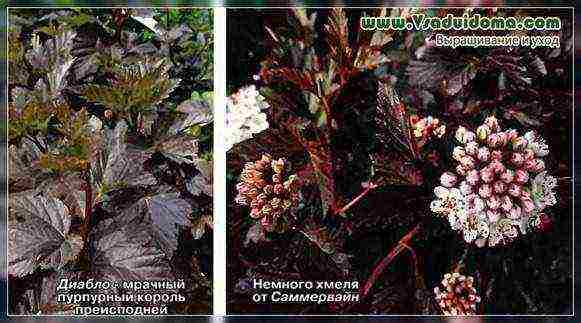
On the Internet I came across such a name - "golden stitch", but I could not find details ... The variety concludes this color range Diabolo d'Or (Diable d'Or)... "Devil's Gold", and this is how the name of the variety can be translated, is distinguished by a slightly lower intensity of the yellow color of the foliage, especially when the leaves are dissolved. However, the sensation of the tips of the shoots flashing like fire is very attractive. Finally, there is yellow-leaved Harer (Nugget) American selection,
also with a more compact habit than that of the progenitor, Luteus.
This is where the theme of the devil, hiding in the details ... of selection, arises in our narrative! It was through the efforts of the famous company "Kordes" (yes, "Kordes" is not only roses!) That gardeners have found an amazing variety Diabolo... The countdown for this achievement begins in 1998.This plant is truly devilish beauty - dark purple, at times almost purple-black leaves are simply eye-catching.
And the flowers of a pale pink color distinguish it very much and adorn it among the mass of other shrubs. Moreover, many of the more modern varieties of the fruit bladder have exactly the same devil in their pedigree! The severity of the devilish beauty was slightly softened by the French originators from the company Minier, almost 15 years ago, who created, so to speak, a light version of the devil called Diabolo d'Or, already mentioned above. Interestingly, it was obtained by crossing the Diablo variety with the old famous Darts Gold. It is certainly in the small details, shades, transient nuances of the color of young and summer foliage that the devil is hidden in those that appeared in the 21st century. varieties of bladderworm.
Moreover, breeders of both the Old and New World had a hand in their creation.
Namesake variety Andre (Andre) lighter, brighter, richer than the devil's progenitor, let's say, more fun. Young leaves in dissolution color the tops of the shoots in light scarlet tones.
Another modern Summer Wine variety (Summer Wine, Summer Wine) Born in 2004 demonstrates the consistency of an old, tart, but dim wine.
The color of its summer foliage has brownish chocolate shades. And in his parents he had all the same Diablo and the form of the vesicle Nanus (R. Monogynus). The variety inherited compactness from parent No. 2.
The devilish gloom in the variety is even more diluted Red Baron... Green moire shines through the purple, creating a sophisticated combination, a play of halftones. Well, after all, the baron, not the emperor, after all ... By the way, in the variety Zolechovca there is even more greenery, but I have not seen this variety in our nurseries. And there is also a variety with a golden border on the leaves (Aureomarginatus), but I have not met it here either.
Like the Nanus variety.
Well, it's enough to talk about the details in which the very devil is hiding, let's move on to the natural and landscape properties and applications of the hero of our story.
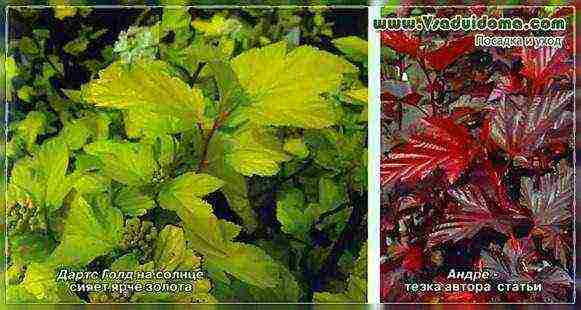
The blooming of the vesicle occurs, as a rule, at the end of June. The flowers are collected in umbellate inflorescences up to 5 cm in size, the flowers themselves are small, decorated with fluffy stamens. In the Diablo variety, flowering evokes an amazing sensation - against the background of purple foliage, a scattering of pale pink inflorescences. This blooming holiday lasts almost a month!
AGROTECHNICS OF BUBBLES is simple and uncomplicated. You should also look for such a plant that is undemanding to growing conditions: sun, partial shade, almost any soil found in gardens, absolute resistance to frost, tolerance to harsh pruning.
The only thing that should be avoided when planting a vesicle is flooded places and areas with a close location of upstream groundwater, as well as excess lime (it is calciophobic) ...
But even there he is quite capable of surviving. In such places, when planting, provide for more substantial drainage or plant on a mound. Our hero will definitely not give up humus. And for yellow-leafed varieties, you should adhere to more illuminated locations. But the purple "devil", even in the shade under the open branches of an oak tree, shows normal growth and acceptable purple foliage.
The bladder is good not only for the spring and summer color of the foliage (depending on the variety), but also for the autumn effects. So, in red-leaved varieties, umbrella-shaped bundles of seed bolls serve as an ornament, including in winter. They are purple first, then chocolate! In yellow-leaved ones, they are reddish, which is also beautiful. Far from all shrubs, the fruits that leave before winter are so decorative, except for the mountain ash or some types of spirits.
And the foliage is gaining color again in the fall - be it the original green, or red-leaved, or yellow-leaved - they turn red, everyone turns yellow!
Of course, all the very, very bright and, if I may say so, the "variety", the vesicles demonstrate in the spring. Then the color of the foliage is muted. And of course, the full palette of foliage colors can only appear in conditions of sufficient lighting. The same Darts Gold, shining in the sun, turns into a pale green in the shade, don't you understand ...
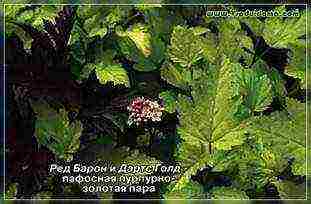 Reproduction of the bladder
Reproduction of the bladder
The bicarp is easily propagated by seeds and no less simply by cuttings (green, before flowering with the use of root formation stimulants), by layering and dividing the bush. Sowing seeds is usually carried out before winter. It should be added that the vesicle also gives active self-seeding. And everything happens according to the monk Mendel - the founder of modern genetics: part of the seeds of the red-leaved form gives me the original green form. It remains only to separate the "wheat from the chaff" and transplant the devils to their permanent habitat. And the green ones will also come in handy ...
Transplanting seedlings should be carried out with as large a lump of earth as possible, either in early spring, or in autumn with the simultaneous pruning of part of the shoots. Spraying on foliage and watering with adaptogens will not interfere.
Even a bush cut on a stump is easily and quickly restored and the next year shows its best qualities - “blooms and smells” ... It is clear that the bushes should be cut and formed only after flowering. This is usually done in the fall. There is, however, one problem I noticed in nurseries. Many colored varieties of the fruit bladder are sometimes released, "shoot", so to speak, with ordinary green shoots. They must be cut out in time as close to the base of the bush as possible. In the spring, sanitary pruning will be in demand: removal of old, broken, thickening and frozen branches.
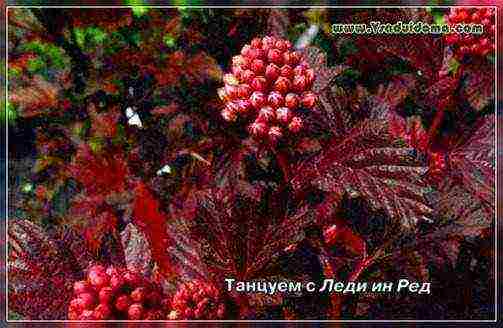
WHAT ABOUT PESTS, I have not met them for more than a dozen years on the vesicle. The fight against chlorosis is solved in a typical way.
By the way, the vesicle is a wonderful honey plant. Its flower brushes are always in demand among bees, bumblebees, butterflies and beetles, such as bronzes.
And a little about the use of the bladder directly in landscape design. Plain green is quite suitable for large, voluminous gardens in a natural style. There it can serve as an element of a free hedge, and a lining under trees. In gardens, the use of the natural form is, perhaps, limited to the creation of sheared hedges, since our hero of the story perfectly withstands this procedure. Applying colored varieties requires a thoughtful approach.
So, the Diabolo variety in large tracts can give the garden a depressing shade. This is a clear loner that will show its color qualities against the background of other, more modest plants. It is wonderful, in my opinion, to combine purple with yellow, white, variegated or salivary companions. For example, the composition of purple-leaved vesicles and purpurea nana willow with thin dove foliage or other light long-leaved plants can create an interesting contrast in the garden.
Also quite harmonious seems to be a combination to one degree or another of a spherical or rather hemispherical form of a bush of vesicles with vertical dominants. Moreover, for both purple-leaved and yellow-leaved companions, blue or blue delphiniums, spruces or ki-parisoviks with bluish needles will be good. For purple ones, tall "wild" (and not only) yellow mulleins, as well as buzzards (for example, the Przhevalsky variety Rocket), are quite suitable. Trellis (supports) with blue, white climbing plants - clematis, princes and others will look great against the background of the vesicles.
It is quite possible to form "garden rooms" from trimmed or freely growing bushes of the vesicle, dividing the garden into thematic fragments. Given their "indestructibility" - this is an almost irreplaceable plant in your garden.
This plant, like Gosha from the movie "Moscow Does Not Believe in Tears", has practically no flaws ... Trust me!
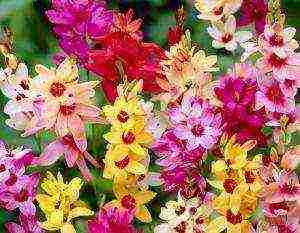 Plants of the family Iris (Iris) hardly need a special introduction, because in almost every area there are stately gladioli, delicate crocuses, graceful montbrecia and fragrant freesia. However, everyone's favorites have such relatives that even seasoned gardeners have not heard of. Ixia is such a mysterious stranger - a herbaceous bulbous perennial that arrived in Europe from distant South Africa. It is not difficult to guess an inhabitant of the tropics in an overseas guest: her wide-open flowers with a dark throat, painted in bright colors, are the very embodiment of the sun and summer. The name of the plant comes from the Greek word "ixsios" - bird glue, because in the homeland the sticky, viscous juice of ixia causes a lot of trouble for hummingbirds, who adore elegant flowers for their specific aroma. The tropicana does not seduce feathered middle latitudes, but it attracts bees and butterflies to the site.
Plants of the family Iris (Iris) hardly need a special introduction, because in almost every area there are stately gladioli, delicate crocuses, graceful montbrecia and fragrant freesia. However, everyone's favorites have such relatives that even seasoned gardeners have not heard of. Ixia is such a mysterious stranger - a herbaceous bulbous perennial that arrived in Europe from distant South Africa. It is not difficult to guess an inhabitant of the tropics in an overseas guest: her wide-open flowers with a dark throat, painted in bright colors, are the very embodiment of the sun and summer. The name of the plant comes from the Greek word "ixsios" - bird glue, because in the homeland the sticky, viscous juice of ixia causes a lot of trouble for hummingbirds, who adore elegant flowers for their specific aroma. The tropicana does not seduce feathered middle latitudes, but it attracts bees and butterflies to the site.
In garden culture, ixia has been known since the end of the 18th century, and the origin of some of its hybrid forms is still not known for certain. Among flower growers, the African woman is reputed to be a capricious and demanding plant, but do not let this scare you - subject to agricultural technology, a relative of gladioli feels quite comfortable in the climate of the middle zone. And then, isn't it great to grow a flower that not everyone manages to make friends with? Take the risk?
The genus Ixia is represented in nature by 25 species, of which the following are of interest to flower growers:
- Green-flowered Ixia is a tall (up to 55 cm in height) plant with long spike-shaped inflorescences collected from small flowers. In contrast to the pale green color of the petals, the bluish-black pharynx looks very original.
- Ixia Hymenokallis pleasant (early), perhaps the most unusual representative of the genus. Its snow-white fragrant flowers with long, curved petals turn the flower garden into a real fairy tale.
- Ixia orange is the shortest representative of the genus, barely reaching a height of 25 cm. Bright orange flowers with a brown-red pharynx exude a tart aroma.
- Ixia spotted is a graceful plant about 50 cm high. Flowers with rounded white-lilac petals and deep dark purple pharynx are collected in long ears.
In culture, such types of ixia are also grown as paniculate, aromatic, oriental, multi-spikelet, one-brother. However, hybrid ixia is most often found in flower beds - a highly decorative perennial 35-50 cm high with narrow belt-like leaves and large funnel-shaped flowers, collected in spikes of 6-12 pieces. There are numerous varieties with flowers of all kinds of shades:
- Vulkan, Castor, Mabel - red, from carmine to brick;
- Marquette, Holland's Glory, Uranus - yellow;
- Hogarth, Giant - creamy white
- Rose Emperor, Englishton - pale pink;
- Blue Bird - blue and white;
- Early Surprise - red and white.
Landscape designers use Ixia to decorate ridges and rock gardens or grow in small groups. In mixborders, the African woman is in harmony with lupins, delphiniums, daylilies, salvias, echinacea, cannes and rudbeckia. A very successful combination with decorative cereals: miscanthus, reed grass, lightning. Non-blooming neighbors will not only set off the exotic beauty of Ixia, but also serve as additional support for its fragile stems. A tropical coquette is ideal for making bouquets, cut inflorescences stand in the water for more than 14 days.
Ixia is propagated by seeds or corms, and planting dates directly depend on the method of cultivation you choose. For seed breeding, it is recommended to sow seedlings in late February - early March, and in May to plant mature seedlings in a permanent place. It is impractical to sow seeds on a flowerbed right away - the probability of their germination is very small.
Corms are planted in open ground also in May, when the soil on the site warms up to + 7 ... + 10 ° C, and night frosts will finally leave the growing region.
Since Ixia came to the culture of mid-latitudes from hot Africa, the site for it should be sunny and calm. In the shade, an exotic guest will simply refuse to bloom. She prefers the soil, loose, well aerated and moisture permeable. The plant does not like stagnation of water at the roots, so avoid places with a high groundwater table.
A flowerbed for a mysterious African woman is prepared in October: the soil is dug up and filled with fertilizers - 10–14 kg of garden humus, 30 g of superphosphate and 25 g of potassium chloride are introduced for each m² of the planting area. Under the repeated spring digging, nitrogen-containing fertilizers (30 g / m²) are embedded.
The most convenient way to breed Ixia is to grow from corms. A month before planting, the bulbs are sorted out, sorted by size and cleaned of dry scales. A few hours before the start of work, the selected material is etched in a solution of Fundazol or Maxim. This measure not only prevents the development of fungal infections, but also stimulates the germination of the bulbs.
The scheme and depth of planting of bulbs depends on their size: large specimens are planted to a depth of 5–7 cm with an interval of 10–12 cm, small onions are buried by 3–5 cm, keeping a distance of 6–8 cm between them. usually in 12-15 days, and the flowering of Ixia will come in June-July. If you can't wait to see flowers, plant the bulbs in pots with loose humus soil in early April, and move them to a flower bed at the end of May.
By the way, this method is not only simple, but also beneficial, because every adult corm forms 3-5 children every year. In the fall, when you dig up ixia, disassemble the "nests", separate the young bulbs, and plant them in the spring. Thus, your humble curtain in a few years will turn into a vast tropical lawn.
If you decide to master the seed reproduction of Ixia, please be patient - the process you have to do, albeit simple, but rather troublesome:
- The day before sowing, soak the Ixia material in clean water, which must be changed every 6-7 hours.
- While the seeds are soaking, mix turf, peat, humus and sand (1: 1: 1: 1), then be sure to sterilize the substrate in a hot oven or water bath.
- Pour the disinfected soil mixture into the seedling box, lightly compact and level.
- Sow the prepared Ixia seeds to a depth of 0.5–0.7 cm. Cover the box with foil or glass and place it as close to the light as possible.
- As soon as the sprouts appear, the shelter is removed from them and the seedlings are provided with proper care, including regular loosening and spraying of the soil with settled water, as well as daily ventilation of the crops and removal of accumulated condensation.
- In the growth phase of the second or third leaf, cut the plants into separate pots.
- 15–20 days before planting, begin to take out the seedlings to the balcony or garden to get used to the new conditions. The duration of the hardening sessions should be increased daily.
Ixia seedlings are transplanted into a flower garden with an earthen lump, maintaining a distance of 10-12 cm between adjacent specimens with a row spacing of 25-30 cm. Upon completion of the work, the seedlings are watered and shaded from the burning sun for the next 2-3 days.
Ixiae bloom from seeds, as a rule, in the second year, although, if the conditions for their development are optimal, the first flowers may bloom already in the current season.
In terms of content, Ixia is quite modest and does not be capricious for no reason. Caring for her is in many ways similar to the agricultural technique of gladioli:
- Every 6-8 days, planting is watered abundantly with settled water heated in the sun. During a period of sweltering heat, watering should be carried out more often, as well as arrange a refreshing shower every night for the plants.
- After moistening or rain, it is advisable to gently loosen the soil under Ixia to prevent the formation of a dense crust. Simultaneously with loosening, the flower garden is cleared of weeds.
- If your beauty grows on fertile soil, you can do without top dressing. However, the poor soil will have to be enriched every 10–12 days, alternating mullein infusion (1:10) and a solution of complete mineral fertilizer (2 g / l).
- It is useful to mulch the soil of the flower garden with peat or humus. Mulch will prevent moisture evaporation and protect plant roots from overheating.
As you can see, Ixia will not require huge efforts from you, and thanks to simple measures your flower garden will look like a holiday card.
In favorable conditions, ixia does not get sick, but insufficient care and dampness can lead to the development of infections such as:
- Gray mold - plant bulbs become covered with felt mold. Since there is no cure for this disease, diseased specimens should be destroyed, and healthy plants should be sprayed with Fundazole solution for prophylaxis.
- Fusarium - characterized by drying of leaves, curvature of shoots, deformation of flowers. As a treatment for infected plants, treatment with copper-containing fungicides ("Oxyhom", "Kuproksat", Bordeaux liquid) is indicated.
- Septoria - most often this infection manifests itself at the end of summer. Below, small reddish-brown spots with a black border are poured on the leaves, the bulbs are covered with grayish tan and brown watery spots, the quality of flowering decreases, and the plants look depressed. Most often, specimens growing on damp clay soils are infected, so it makes sense to change the site or improve the structure of the soil. Sick plants are sprayed with Bordeaux liquid, and heavily affected bulbs are discarded.
- Jaundice, or herbaceousness, is an incurable viral disease, the first sign of which is the rapid yellowing of the leaves. The deadly yellowness spreads from the tips of the leaves, and soon the whole bush acquires a rich straw hue. They carry a dangerous leafhopper virus.
Of the pests, tender ixia is most often affected by sucking insects that feed on the cell sap of plants - aphids, thrips, spider mites. Due to the attack of parasites, the foliage of plants becomes covered with discolored spots and dots, the shoots are deformed, and the flowers lose their attractiveness. To save the flower garden, powerful insecticides are used: Karbofos, Agravertin, Confidor, Fitoverm.
Ixia and bear bothers, for whom juicy bulbs are a delicious delicacy. Special preparations such as Medvetox, Grizzly, Medvegon, Fenaxin Plus will help to get rid of insects and their offspring. If you prefer to do without chemicals, try to lure soil-living parasites into traps: in September, dig holes in an area with a depth of 0.4–0.5 m, fill them with fresh horse manure and sprinkle them with earth. When the frost hits, open the traps and destroy the adult bear. You do not need to spend energy on the larvae, they will die from the cold.
Despite the fact that Ixia is a perennial plant, it does not hibernate in the open ground of the middle lane. In October, the “nests” of the bulbs are dug up, shaken off the ground and dried in a cool (about + 10 ° C), well-ventilated room or outdoors, under a canopy. The prepared material is placed in wooden boxes or cardboard boxes, sprinkled with sand or peat and stored in a non-freeze cellar at a temperature of + 6 ... + 8 ° C. You can wrap the bulbs in a heavy perforated paper bag and store them in the vegetable compartment of your refrigerator until spring.
If you live in the south, it is not necessary to dig Ixia in the fall; it is enough to cover the flowerbed with spruce paws or dry leaves.In addition, in regions where the soil does not freeze, the bulbs can be planted before winter, but this should not be done earlier than November, otherwise the bulbs will germinate before the onset of cold weather and die from the first frost.
Spirea, otherwise mistakenly called meadowsweet, is a perennial shrub. Currently, breeders have bred about a hundred species of spirea.
The plant is distinguished by its hardiness and the ability to adapt to any conditions in the open field. For Japanese spirea, it is enough only four hours to be in the open sun to feel good in the ground. In appearance, it is a bush with a hemispherical crown. Some of its varieties have a lush crown, others - disheveled.
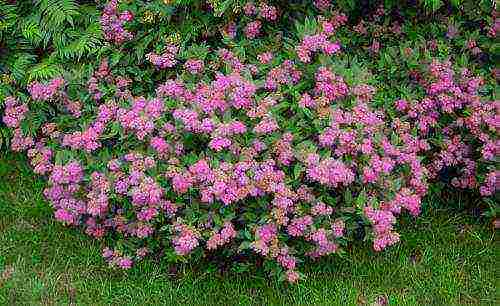
How and when does the spirea plant
Planting a bush in open ground is carried out either in early autumn, or at the very beginning of spring. Planting time usually depends on the selected bush variety. If the variety begins to bloom in the spring, then it is advisable to move it into open ground in the fall. If in the summer, then it is better if the spirea is planted in the spring. It is important to consider that flowering after planting in the soil occurs only after three years. Japanese spirea begins to bloom in July.
Usually, seedlings are purchased to decorate the site. Before planting in open ground, they must be carefully prepared.
First, you should check the root system of the future bush. Long roots are slightly pruned, damaged ones are removed. Secondly, you need to cut the stem by a third.
If you purchased a seedling for planting, the root system of which is closed, it is removed from the container and watered well with water. If the clod of earth around the roots is very dense, then it is also soaked in water for about two hours. Only then can the seedling be moved into open ground.
Although spiraea is considered an unpretentious plant, you still need to choose the right place for planting.
Only then will she delight you with lush and bright flowering. The shrub loves the sun and loose fertile soil. With a clay composition of the soil, it is best to create a brick-sand drainage, the height of which will be 15 cm.
To create a beautiful landscape design, the spirea can be planted along the entire perimeter as a hedge. In this case, the distance from bush to bush must be at least 50 cm.
After you dug a hole, it needs to stand for a day before planting. Then a mixture of peat, turf and sand is introduced into it. The plant is planted in open ground, spreading the roots, and sprinkled with earth along the root collar. After that it is watered and mulched with peat.
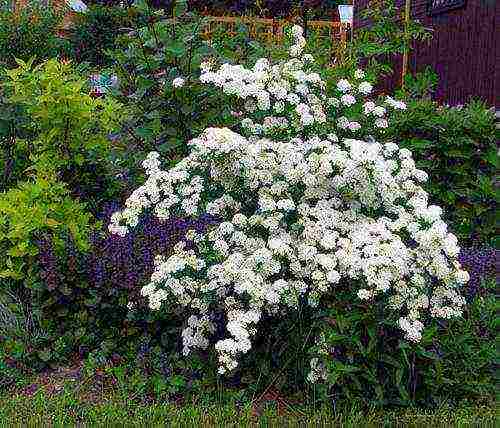
Spirea care
When the planting of Japanese spirea in open ground is over, you just have to take care of the development of the bush in time. Care consists in watering.
This plant, being blooming in summer, needs more abundant watering than the spirea species that bloom early.
Care also includes fertilization. The shrub is fed no more than three times a season, although it is usually fertilized only twice. For feeding, it is best to use mineral complexes. You can also resort to the following fertilizer recipe: take 10 liters of liquid manure, 60 liters of water and just 10 grams of superphosphate.
Spirea care includes pruning. If the plant blooms in summer, then you need to cut it off in early spring.
If your shrub blooms in the spring, then prune it immediately after flowering.
Some gardeners say that Japanese spirea does not require pruning. On the one hand, this is true: even without cutting, it will bloom beautifully. On the other hand, the lack of such care can lead to her sloppy appearance.

To cut the plant correctly, you need to take into account the timing of the inception of its buds. There are two groups of shrubs. In the first, they are laid directly in the year of flowering, and in the second, in the previous year.
Japanese spirea varieties belong to the first group. It should be cut after a few years, thus rejuvenating the bush.Without this care, the old stems will, after a while, tilt the entire bush down, and the top of the Japanese spirea will dry out. It is a practice to completely cut off the top of the bush after four years of flowering.
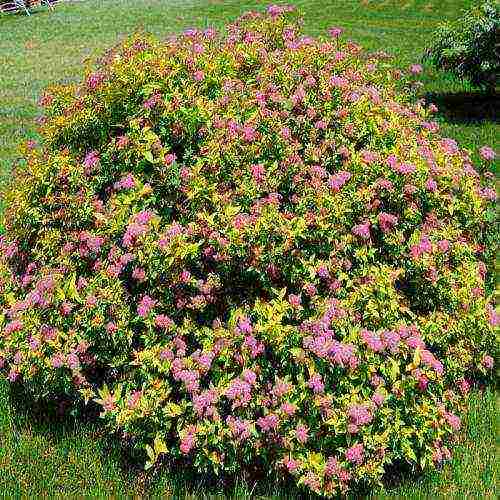
If you nevertheless acquired the types of spiraea of the second group, and these include wangutta spirea, long-bud and nippon, old shoots should be removed after seven years. Frozen branches are cut annually. Plants of this group have many shoots.
Japanese spirea tolerates frost well, so it does not need additional shelter for the winter in a temperate climate. And yet, in severe frosts, it can lose two-year-old shoots. Therefore, for the winter in northern latitudes, it is bent to the ground and covered with a layer of dry leaves. It is also better to protect species that were planted in the fall from winter cold. Some varieties can easily tolerate frosts of -50 degrees. But if your garden is located in an area where winters are very harsh, varieties such as jagged or white, it is better to still cover. They are less cold-resistant. There are types of spirea that can not only freeze branches, but also die in frosts of about -45 degrees. These include spirea wangutta or Douglas. Therefore, it is better not to acquire these varieties at all for cultivation in northern latitudes.
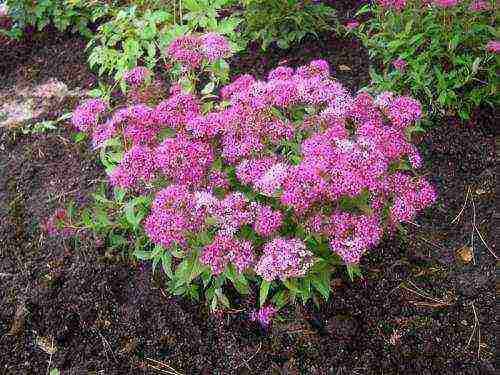
Reproduction of the spirea bush
The plant can be propagated using seeds, layers or cuttings. The seed method is only suitable for non-hybrid varieties.
If you try to plant a seed of a hybrid in open ground, then the appearance of the plant will resemble the mother's very distantly.
Seeds are planted in the spring. It is important to prepare a place for the seed before planting. To do this, take a mixture of leafy earth and peat, moisten it, put a seed and mulch the soil. You will notice shoots within 10 days. So that they are not struck by the fungus, they use foundation treatment.
When propagated by seeds in the first year after germination, the plant will form only one shoot. Two months after planting, the spirea needs to be dived: removed from the soil, shortened the root system and planted again in open ground.
In one year, the shrub grows up to ten centimeters, but it will begin to bloom only after at least three years.
For propagation by cuttings, you need to take green cuttings or shoots in which lignification has occurred halfway. If you have chosen an early variety of spirea, it should be cut in early summer. Reproduction of Japanese spirea using cuttings is best done in July.
After you have received the cutting, you should plant it in a mixture of river sand and peat. It should be watered five times a day. And in the room in which the planting material is located, you need to create high humidity. The stalk dives in the spring.
Before flowering, the plant is propagated by layering. To do this, the branches, concentrated along the perimeter, are bent to the bottom and sprinkled with soil. With regular watering, more plant bushes will appear in the fall. For a successful overwintering, the layers are sprinkled with leaves. And in the spring they can already be planted separately.
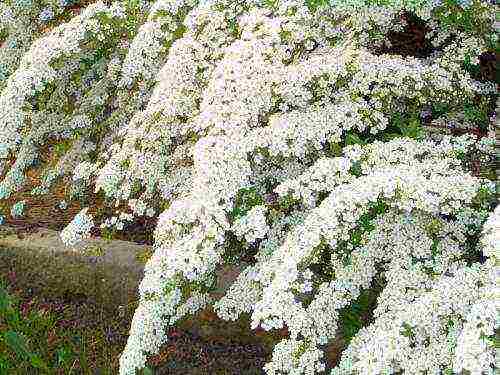
Varieties of spirea and their varieties
Despite the popularity of Japanese spirea, you can pay attention to its other types.
Early bushes include spiraea wangutta, gray, arguta, nippon.
Gray spirea is actually white, but so named because of the grayish tint of the leaves. It is a hybrid of two varieties. The height of the bush usually reaches 180 cm. Flowering begins in mid-May and ends in mid-June. It is very popular among gardeners. Especially her variety "Grefsheim", the crown diameter of which reaches two meters. White flowers are collected in umbrellas and reach a centimeter in diameter.
Spirea wangutta grows up to two meters. This is also the diameter of the crown. The dark green leaves are bluish on the underside, and by autumn they acquire a beautiful orange tint. White flowers cover the entire branch.The variety begins to bloom in June, and may recur in August.
Spiraea wangutta of the Pink Ice variety looks great on the garden plot.
Usually this variety is used as a hedge.
Spirea nipponskaya is also considered a tall shrub, reaching a height of two meters.
It is noteworthy that even in autumn its leaves retain their green color.
Its flowers also differ in shade: they are not white, but yellow-green. They are purple inside the bud.
A variety of argut gained popularity due to its beautifully shaped two-meter bush. Its branches spread out so that from the side it looks like a waterfall. A lot of white flowers are formed on the branches, exuding a pleasant aroma.
Summer-flowering varieties include Japanese spirea, Douglas, Bouvald, willow, Bullard. Usually the flowers of these shrubs have a pink tint. Among the summer-flowering varieties, it is the varieties of Japanese spirea that are especially popular.
Japanese spirea reaches one and a half meters in height, although it can grow up to a meter.
Its leaves are also gray-gray underneath. In autumn, they change color, becoming red-yellow. It is noteworthy that Japanese spirea blooms for about 45 days.
Among its varieties, five can be distinguished, which are especially loved by landscape designers and gardeners.
"Little princesses" is a Japanese spirea that grows a little more than half a meter. Small and diameter of its crown with reddish pink flowers. But their diameter is more than three centimeters. The variety grows slowly.
"Golden princesses" - a variety of Japanese spirea differs from the previous one only in the yellow color of the flowers and the height of the bush in a meter.
Among the low varieties of Japanese spirea, "Shirobana" is noted, which grows up to 60 cm. It has small pink flowers, the diameter of which is two centimeters.
"Goldflame" is a kind of Japanese spirea, the height of which is 80 cm. The flowers are red with a shade of pink. By autumn, the leaves change color to crimson.
"Crispa" is a Japanese spirea, reaching 50 cm. It has a spherical crown. Its inflorescences do not hang down, but are directed upwards. The diameter of pink flowers with a lilac shade is about six centimeters. This variety can bloom for two months.
Another type of shrub that blooms in summer is the Boomald spirea.
This hybrid is based on Japanese and white-flowered spirea. In height, it can be either 50 cm or 80 cm. The shade of flowers is light pink or dark red. By autumn, the leaves change color from green to picturesque orange, yellow and purple.
One of the most famous of its varieties is "Goldflame". It differs in that its leaves have an orange tint, which turns red in autumn. However, if the location of the bush is in the shade, then the leaves will be green.
The willow spirea is also distinguished by shoots that grow upward. Long inflorescences have a pink tint.
The Douglas variety has small green leaves and dark pink flowers. The inflorescences are shaped like a pyramid. The plant pleases with flowering for about one and a half months.
Spirea Billard is a hybrid of the latter two species. Grows up to two meters. The leaves are small, and the bright pink flowers gather in long pyramidal inflorescences.
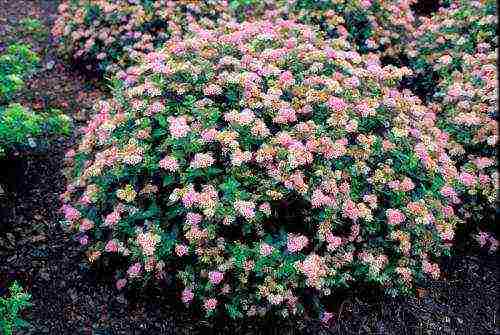
Shrub in landscape design
The advantages of spirea are that different varieties of it bloom at different times. So, if you wish, you can ensure that its bushes will bloom from spring to autumn. Moreover, the shade of flowers will beautifully shimmer from white to pink.
Plant species have their own special functionality, well known to designers. For single landings, the Wangutta, Douglas or sharp-toothed spirea is best suited. Their arched shoots are able to create a beautiful bush shape.
Its low types are suitable for registration of the edging planting. Such spireas will look great in green-leaved compositions, especially if their shoots have a reddish tint, and the flowers are red in color.They are also perfect for decorating rock gardens and rockeries. It is interesting to note that it is the undersized varieties that have a wide root system, which seems to be drawing on the ground. It is worth noting that in addition to its decorative properties, spirea can be called a healing plant: it cleans the air well.
